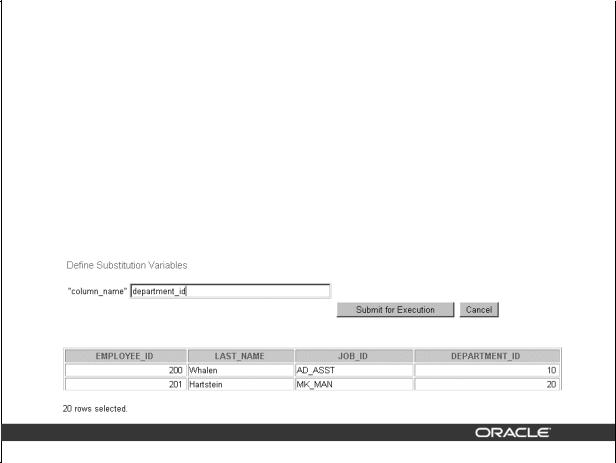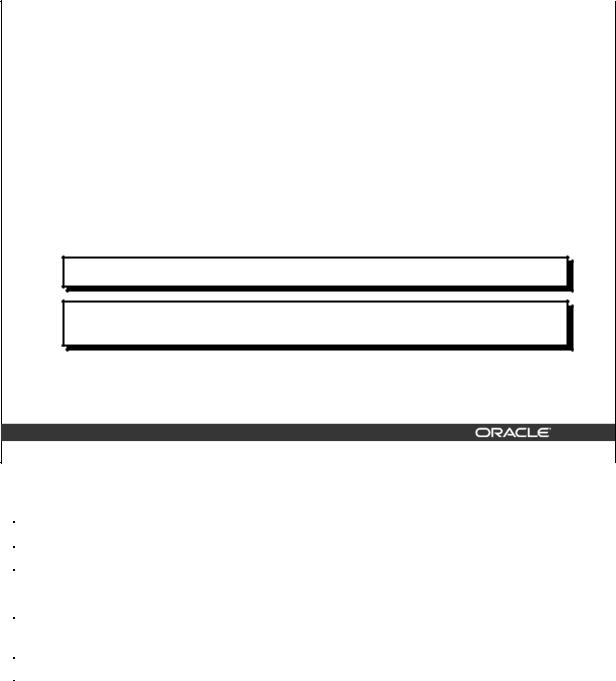|
|
Specifying Column Names, |
|
|
Expressions, and Text |
|
|
|
|
|
|
|
SELECT |
|
employee_id, last_name, job_id, |
|
|
|
&column_name |
|
|
|
FROM |
|
|
|
|
|
employees |
|
|
WHERE |
|
&condition |
|
|
|
ORDER BY |
|
&order_column |
; |
|
|
|
|
|
|
|
|
|
|
|
|
|
|
|
|
|
|
|
|
|
|
|
|
7-9 |
Copyright © Oracle Corporation, 2001. All rights reserved. |
Specifying Column Names, Expressions, and Text (continued)
The slide example displays the employee number, name, job title, and any other column specified by the user at run time, from the EMPLOYEES table. You can also specify the condition for retrieval of rows and the column name by which the resultant data has to be ordered.
Introduction to Oracle9i: SQL Basics 7-9
Defining Substitution Variables
•You can predefine variables using the iSQL*Plus DEFINE command.
DEFINE variable = value creates a user variable with the CHAR data type.
•If you need to predefine a variable that includes spaces, you must enclose the value within single quotation marks when using the DEFINE command.
•A defined variable is available for the session
7-10 |
Copyright © Oracle Corporation, 2001. All rights reserved. |
Defining Substitution Variables
You can predefine user variables before executing a SELECT statement. iSQL*Plus provides the DEFINE command for defining and setting substitution variables:
Command |
Description |
|
|
DEFINE variable = value |
Creates a user variable with the CHAR data and assigns a |
|
value to it |
|
|
DEFINE variable |
Displays the variable, its value, and its data type |
|
|
DEFINE |
Displays all user variables with their values and data |
|
types |
Introduction to Oracle9i: SQL Basics 7-10
DEFINE and UNDEFINE Commands
•A variable remains defined until you either:
–Use the UNDEFINE command to clear it
–Exit iSQL*Plus
•You can verify your changes with the DEFINE command.
DEFINE job_title = IT_PROG
DEFINE |
job_title |
|
DEFINE |
JOB_TITLE |
= "IT_PROG" (CHAR) |
UNDEFINE job_title
DEFINE job_title
SP2-0135: symbol job_title is UNDEFINED
7-11 |
Copyright © Oracle Corporation, 2001. All rights reserved. |
The DEFINE and UNDEFINE Commands
Variables are defined until you either:
•Issue the UNDEFINE command on a variable
•Exit iSQL*Plus
When you undefine variables, you can verify your changes with the DEFINE command. When you exit iSQL*Plus, variables defined during that session are lost.
Introduction to Oracle9i: SQL Basics 7-11
Using the DEFINE Command with
&Substitution Variable
•Create the substitution variable using the DEFINE command.
DEFINE employee_num = 200
•Use a variable prefixed with an ampersand (&) to substitute the value in the SQL statement.
SELECT employee_id, last_name, salary, department_id FROM employees
WHERE employee_id = &employee_num ;
7-12 |
Copyright © Oracle Corporation, 2001. All rights reserved. |
Using the DEFINE Command
The example on the slide creates an iSQL*Plus substitution variable for an employee number by using the DEFINE command, and at run time displays the employee number, name, salary, and department number for that employee.
Because the variable is created using the iSQL*Plus DEFINE command, the user is not prompted to enter a value for the employee number. Instead, the defined variable value is automatically substituted in the SELECT statement.
The EMPLOYEE_NUM substitution variable is present in the session until the user undefines it or exits the iSQL*Plus session.
Introduction to Oracle9i: SQL Basics 7-12
Using the && Substitution Variable
Use the double-ampersand (&&) if you want to reuse the variable value without prompting the user each time.
|
|
|
|
|
|
|
SELECT |
employee_id, last_name, job_id, |
&&column_name |
|
|
FROM |
employees |
|
|
|
|
|
|
ORDER BY |
&column_name; |
|
|
|
|
|
|
|
|
|
|
|
|
|
|
|
|
|
|
|
|
|
|
|
|
|
|
|
|
|
|
|
|
|
…
7-13 |
Copyright © Oracle Corporation, 2001. All rights reserved. |
Double-Ampersand Substitution Variable
You can use the double-ampersand (&&) substitution variable if you want to reuse the variable value without prompting the user each time. The user will see the prompt for the value only once. In the example on the slide, the user is asked to give the value for variable column_name only once. The value supplied by the user (department_id) is used both for display and ordering of data.
iSQL*Plus stores the value supplied by using the DEFINE command; it will use it again whenever you reference the variable name. Once a user variable is in place, you need to use the UNDEFINE command to delete it.
Introduction to Oracle9i: SQL Basics 7-13
Using the VERIFY Command
Use the VERIFY command to toggle the display of the substitution variable, before and after iSQL*Plus replaces substitution variables with values.
SET VERIFY ON
SELECT employee_id, last_name, salary, department_id FROM employees
WHERE employee_id = &employee_num;
|
|
|
|
|
|
|
|
|
|
|
|
|
|
|
|
|
|
|
old |
3: |
WHERE |
employee_id |
= |
&employee_num |
|
|
|
new |
3: |
WHERE |
employee_id |
= |
200 |
|
|
|
|
|
|
|
|
|
|
|
|
|
|
|
|
|
|
|
|
7-14 |
Copyright © Oracle Corporation, 2001. All rights reserved. |
The VERIFY Command
To confirm the changes in the SQL statement, use the iSQL*Plus VERIFY command. Setting SET VERIFY ON forces iSQL*Plus to display the text of a command before and after it replaces substitution variables with values.
The example on the slide displays the old as well as the new value of the EMPLOYEE_ID column.
Introduction to Oracle9i: SQL Basics 7-14
Customizing the iSQL*Plus Environment
•Use SET commands to control current session.
SET system_variable value
•Verify what you have set by using the SHOW command.
SET ECHO ON
SHOW ECHO echo ON
7-15 |
Copyright © Oracle Corporation, 2001. All rights reserved. |
Customizing the iSQL*Plus Environment
You can control the environment in which iSQL*Plus is currently operating by using the SET commands.
Syntax
SET system_variable value
In the syntax:
system_variable is a variable that controls one aspect of the session environment
value |
is a value for the system variable |
You can verify what you have set by using the SHOW command. The SHOW command on the slide checks whether ECHO had been set on or off.
To see all SET variable values, use the SHOW ALL command.
For more information, see iSQL*Plus User’s Guide and Reference, “Command Reference.”
Introduction to Oracle9i: SQL Basics 7-15
SET Command Variables
• |
ARRAYSIZE |
{20 | n} |
• |
FEEDBACK |
{6 | n |OFF | ON} |
• |
HEADING |
{OFF | |
ON} |
• |
LONG {80 |
| n}| |
ON | text} |
|
|
|
|
SET HEADING OFF
SHOW HEADING
HEADING OFF
7-16 Copyright © Oracle Corporation, 2001. All rights reserved.
SET Command Variables
SET Variable and Values |
Description |
|
|
ARRAY[SIZE] {20| n} |
Sets the database data fetch size |
|
|
FEED[BACK] |
Displays the number of records returned by a query when the |
{6|n|OFF|ON} |
query selects at least n records |
|
|
HEA[DING] {OFF|ON} |
Determines whether column headings are displayed in reports |
|
|
LONG {80|n} |
Sets the maximum width for displaying LONG values |
|
|
Note: The value n represents a numeric value. The underlined values indicate default values. If you enter no value with the variable, iSQL*Plus assumes the default value.
Introduction to Oracle9i: SQL Basics 7-16

iSQL*Plus Format Commands
•COLUMN [column option]
•TTITLE [text | OFF | ON]
•BTITLE [text | OFF | ON]
•BREAK [ON report_element]
7-17 Copyright © Oracle Corporation, 2001. All rights reserved.
Obtaining More Readable Reports
You can control the report features by using the following commands:
Command |
Description |
|
|
COL[UMN][column option] |
Controls column formats |
|
|
TTI[TLE] [text|OFF|ON] |
Specifies a header to appear at the top of each page of the |
|
report |
BTI[TLE] [text|OFF|ON] |
Specifies a footer to appear at the bottom of each page of |
|
the report |
|
|
BRE[AK] [ON |
Suppresses duplicate values and divides rows of data into |
report_element] |
sections by using line breaks |
|
|
Guidelines
•All format commands remain in effect until the end of the iSQL*Plus session or until the format setting is overwritten or cleared.
•Remember to reset your iSQL*Plus settings to the default values after every report.
•There is no command for setting an iSQL*Plus variable to its default value; you must know the specific value or log out and log in again.
•If you give an alias to your column, you must reference the alias name, not the column name.
Introduction to Oracle9i: SQL Basics 7-17
The COLUMN Command
Controls display of a column:
COL[UMN] [{column|alias} [option]]
CLE[AR]: Clears any column formats
HEA[DING] text: Sets the column heading
FOR[MAT] format: Changes the display of the column using a format model
NOPRINT | PRINT
NULL
7-18 Copyright © Oracle Corporation, 2001. All rights reserved.
COLUMN Command Options
Option |
Description |
|
|
CLE[AR] |
Clears any column formats |
|
|
HEA[DING] text |
Sets the column heading (a vertical line (|) forces a line feed in the |
|
heading if you do not use justification.) |
FOR[MAT] format |
Changes the display of the column data |
NOPRI[NT] |
Hides the column |
|
|
NUL[L] text |
Specifies text to be displayed for null values |
|
|
PRI[NT] |
Shows the column |
Introduction to Oracle9i: SQL Basics 7-18











